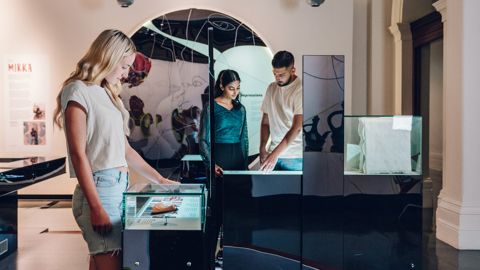Microbe map
In a museum world first, visitors have truly become part of the exhibition by sharing their microbial DNA fingerprint—at the same time contributing to medical research.
The microbe map installation created for Gut Feelings (on display March 2019–August 2020, Melbourne Museum) has revealed the secrets of Victorians’ microbiomes, offering a new understanding about the microbes that live in our mouths—aka the gut entrance—and how they vary with different lifestyles and diets.
Melbourne Museum, the University of Melbourne and the Peter Doherty Institute for Infection and Immunity created this joint research project.
Using the map
- Zoom: use the mouse wheel / pinch-to-zoom gesture (mobile)
- Pan: left-click + hold the mouse and drag / move finger across map (mobile)
- Rotate: right-click + hold the mouse and drag
- Hover over / touch (mobile) a suburb for details
- Purple indicates higher diversity, height indicates sample size
About the State of Our Microbes: Victorian Oral Microbiome and Lifestyle Study
Having a rich and diverse community of microbes is good for us, but how do our lifestyles affect this mix? Does who we live with influence our microbial richness? Eating well and spending time in nature might be beneficial for obtaining a diverse microbiome, but what about owning a pet? Or drinking tea vs. coffee? Or even where we live?
To investigate these questions and others, we have created a digital microbe map of Victoria, by taking a sample from one end of the gut: the mouth. Visitors were invited to donate a microbe-containing spit sample, and fill out a survey about the food they ate, their pets, sleeping habits and more.
Researchers from the University of Melbourne and the Peter Doherty Institute for Infection and Immunity whisked the tiny tubes of saliva away for microbial DNA sequencing. They then profiled and compared the community of creatures living in the mouths of Victorians. All results were de-identified for privacy. No individual results were given to participants, as this was not a health diagnostic project, but rather a study on the microbiomes of people within a community.
1,450 adults and children took part in the study, and the dynamic microbe map has been on display at the entrance of Gut Feelings throughout the project—growing with new data that reveals the microbial diversity of participants from across Victoria.
Microbes, including bacteria, affect people's physical and mental health via immune, hormone and nerve pathways. Generally, the higher the microbe diversity the better! Think of it like a tiny balanced ecosystem.
We found that:
- Microbe proportions are carb-sensitive
High carbohydrate intakes, such as added sugar and refined flours, were associated with lower microbe diversity in participants’ saliva. 88% of adults reported not eating the recommended five serves of vegetables a day, and 30% reported eating one or fewer serves a day. Indicating that Victorians should be eating more fruit and vegetables to increase the health of their microbes! - Antibiotics decrease bacterial diversity
The results show a drop in microbe diversity in participants who had recently taken antibiotics—as we would hope for even in this age of superbugs. - We aren’t so special
At first glance of these preliminary results the common bacterial phyla (such as the Proteobacteria and Firmicutes) and genera (Neiseseria, Haemophilus) are broadly the same in Victorians as those seen in the mouths of people in other parts of the world. Could an ideal human microbiome exist? - Your flatmates matter
There was a trend towards higher microbe diversity when participants shared their home with one person or more. Further sampling may give the researchers a statistically significant result. - Victorians have varied microbe fingerprints
While broad human patterns exist, the balance of microbes in an individual differs so much you could refer to it as a fingerprint. The results show that postcodes varied in average microbe diversity, but the more samples received the more differences started to average out. Interestingly, the anticipated pattern of higher microbe diversity in country vs. city was not there—however the highest scorer, our ‘super spitter’, did come from the country. - We can’t be pigeonholed by one variable
As for the questions of whether microbes differ between dog owners and cat owners? And coffee and tea drinkers? Northsiders and southsiders? The huge data sets need more analysis before the researchers can say for sure. Your lifestyle interplay with microbes is complex and looking at a single factor—like your coffee habits—either doesn’t have a huge effect or isn’t enough to single you out in our current results.
Meet your microbes...







